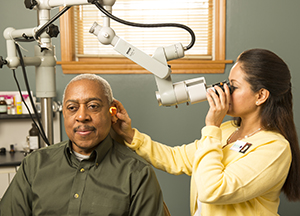Treatment for Ear Barotrauma
Ear barotrauma is a type of ear damage. It's caused by a difference in pressure between the inside of the ear and the air around you. It can cause pain and may lead to lasting hearing loss. It can harm the eardrum. The eardrum is between the outer and middle ear. Harm to the eardrum can cause bleeding or other damage to the outer, middle, or inner ear.
Flying is the most common cause of barotrauma. It can also happen with driving in the mountains, decompression, scuba diving, a blast injury or explosion, or treatment in a hyperbaric oxygen chamber.

Types of treatment
You may be referred to an ear, nose, and throat health care provider (ENT or otolaryngologist). Or you may not need any treatment. Most barotrauma injuries heal on their own with time, and your symptoms will go away. But your eardrum may not heal normally if a blast caused the injury.
Your provider may tell you to rest in bed with your head raised on a pillow. Keep your ear dry. Ask your provider how to prevent your affected ear from getting wet when taking a bath or shower.
You may also need to take medicine, such as:
-
Pain medicines.
-
Antibiotics, if an infection develops or is likely to develop. If your provider prescribes antibiotics, take them as directed. Do not stop taking them just because you feel better. You need to take the full course of antibiotics.
You may need surgery if your ear barotrauma is severe. A surgeon may rebuild the eardrum or the opening into the inner ear. A tiny cut may be made in the eardrum. In rare cases, a ventilation tube in the eardrum may be needed to equalize pressure between the middle ear and outside air.
What happens if you don’t get treated?
In some cases, ear barotrauma can cause symptoms that don’t go away, such as:
Follow your provider’s advice about bed rest or surgery. This may help cut your risk for these problems.
Preventing ear barotrauma
You can take steps to help prevent ear barotrauma. If you are congested from a cold or allergies, you may want to delay flying, driving in the mountains, or scuba diving. Or you can take medicines, such as a decongestant or antihistamine. These may help your ears equalize more easily and prevent ear barotrauma.
You can do some things to open the eustachian tube during pressure changes, such as:
-
Swallowing often.
-
Pinching your nose, closing your mouth, and then acting as if you were going to breathe out through your nose.
-
Chewing gum or candy.
-
Using special ear plugs when flying.
The eustachian tube links the middle ear to the throat to equalize pressure and drain fluid as needed. Using a ventilation tube is a choice for some people whose eustachian tubes don’t work well or for those who need to fly often. These may help you if you need high pressure oxygen therapy for wound healing. A surgeon places these tubes in the eardrum. They help even out pressure differences. Ventilation tubes can't prevent ear barotrauma caused by diving.
Coping with ear barotrauma
If you're a diver, don’t dive again until your injury has fully healed. Diving too soon can cause injury again. Your provider will tell you when it's safe for you to dive again. You should also not fly until your provider says it's OK.
When to contact your doctor
Contact your provider right away if:
-
Your symptoms don’t get better, or they get worse.
-
You have any new symptoms, such as dizziness, pain, fever, or hearing loss.